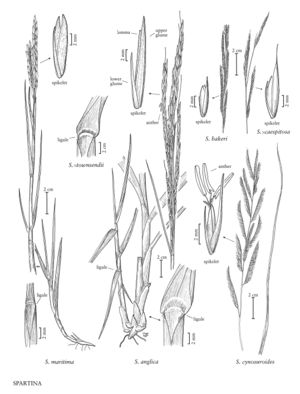Difference between revisions of "Spartina ×caespitosa"
FNA>Volume Importer |
RevisionBot (talk | contribs) m (Bot: Adding category Revised Since Print) |
||
| (10 intermediate revisions by 3 users not shown) | |||
| Line 17: | Line 17: | ||
-->{{Treatment/Body | -->{{Treatment/Body | ||
|distribution=Maine;Md.;N.J.;Mass.;N.B.;N.S.;P.E.I.;Va.;Conn.;N.Y.;Del.;N.H.;R.I. | |distribution=Maine;Md.;N.J.;Mass.;N.B.;N.S.;P.E.I.;Va.;Conn.;N.Y.;Del.;N.H.;R.I. | ||
| − | |discussion=<p>Spartina ×caespitosa is found in disturbed areas of the drier portions of salt and brackish marshes, at some distance above the intertidal zone. It occurs sporadically along the coast from Maine to Maryland, a region where its putative parents, S. pectinata and S. patens, are sympatric. None of the populations Mobberley (1956) examined was growing in undisturbed land.</p><!-- | + | |discussion=<p><i>Spartina ×caespitosa</i> is found in disturbed areas of the drier portions of salt and brackish marshes, at some distance above the intertidal zone. It occurs sporadically along the coast from Maine to Maryland, a region where its putative parents, <i>S. pectinata</i> and <i>S. patens</i>, are sympatric. None of the populations Mobberley (1956) examined was growing in undisturbed land.</p><!-- |
| − | --><p>Mobberley's (1956) investigations led him to conclude that the populations of S. ×caespitosa are polythetic in origin. Part of the evidence for his conclusion was the variability he observed. It is this variability that makes it necessary to bring out the hybrid at several locations in the key. Its distribution is, however, very limited, a fact that may be more useful for identification than any of the morphological characteristics examined.</p> | + | --><p>Mobberley's (1956) investigations led him to conclude that the populations of <i>S. ×caespitosa</i> are polythetic in origin. Part of the evidence for his conclusion was the variability he observed. It is this variability that makes it necessary to bring out the hybrid at several locations in the key. Its distribution is, however, very limited, a fact that may be more useful for identification than any of the morphological characteristics examined.</p> |
|tables= | |tables= | ||
|references= | |references= | ||
| Line 27: | Line 27: | ||
-->{{#Taxon: | -->{{#Taxon: | ||
name=Spartina ×caespitosa | name=Spartina ×caespitosa | ||
| − | |||
|authority=A. A. Eaton | |authority=A. A. Eaton | ||
|rank=species | |rank=species | ||
| Line 34: | Line 33: | ||
|basionyms= | |basionyms= | ||
|family=Poaceae | |family=Poaceae | ||
| + | |illustrator=Linda A. Vorobik;Linda Bea Miller | ||
| + | |illustration copyright=Utah State University | ||
|distribution=Maine;Md.;N.J.;Mass.;N.B.;N.S.;P.E.I.;Va.;Conn.;N.Y.;Del.;N.H.;R.I. | |distribution=Maine;Md.;N.J.;Mass.;N.B.;N.S.;P.E.I.;Va.;Conn.;N.Y.;Del.;N.H.;R.I. | ||
|reference=None | |reference=None | ||
| Line 39: | Line 40: | ||
|publication year= | |publication year= | ||
|special status= | |special status= | ||
| − | |source xml=https:// | + | |source xml=https://bitbucket.org/aafc-mbb/fna-data-curation/src/200273ad09963decb8fc72550212de541d86569d/coarse_grained_fna_xml/V25/V25_864.xml |
|subfamily=Poaceae subfam. Chloridoideae | |subfamily=Poaceae subfam. Chloridoideae | ||
|tribe=Poaceae tribe Cynodonteae | |tribe=Poaceae tribe Cynodonteae | ||
| Line 46: | Line 47: | ||
}}<!-- | }}<!-- | ||
| − | -->[[Category:Treatment]][[Category:Spartina]] | + | --> |
| + | |||
| + | [[Category:Treatment]] | ||
| + | [[Category:Spartina]] | ||
| + | [[Category:Revised Since Print]] | ||
Latest revision as of 18:30, 28 May 2021
Plants rhizomatous or not; rhizomes, when present, thick, usually purplish-brown, scales closely imbricate. Culms to 120 cm tall, 1-3 mm thick, indurate, solitary or in small, dense clumps. Sheaths mostly glabrous, throats glabrous or short-pilose; ligules 0.5-1 mm; blades 8-56 cm long, 2-6(7) mm wide, usually involute, abaxial surfaces glabrous, adaxial surfaces glabrous or scabrous, margins strongly scabrous, blade of the second leaf below the panicles 8-56 cm long, 2-5(7) mm wide. Panicles 9-20 cm, not smoothly cylindrical, with 3-9 branches; branches 3-9 cm, appressed or spreading, with 20-50 spikelets. Spikelets 10-17 mm, lanceolate to ovate-lanceolate. Glumes glabrous or sparsely hispidulous, keels glabrous, hispid in whole or in part, or ciliate; lower glumes 4-9 mm, acuminate or awned; upper glumes 10-17 mm, exceeding the florets, keels hispid, lateral veins prominent, 1 on each side of the keel or 2-3 on 1 side of the keel, apices acuminate or awned; lemmas glabrous or sparsely hispidulous, apices obtuse, rounded, obscurely lobed, or apiculate; anthers 3-6 mm, poorly filled, indehiscent. 2n = 60, 60+2.
Distribution
Maine, Md., N.J., Mass., N.B., N.S., P.E.I., Va., Conn., N.Y., Del., N.H., R.I.
Discussion
Spartina ×caespitosa is found in disturbed areas of the drier portions of salt and brackish marshes, at some distance above the intertidal zone. It occurs sporadically along the coast from Maine to Maryland, a region where its putative parents, S. pectinata and S. patens, are sympatric. None of the populations Mobberley (1956) examined was growing in undisturbed land.
Mobberley's (1956) investigations led him to conclude that the populations of S. ×caespitosa are polythetic in origin. Part of the evidence for his conclusion was the variability he observed. It is this variability that makes it necessary to bring out the hybrid at several locations in the key. Its distribution is, however, very limited, a fact that may be more useful for identification than any of the morphological characteristics examined.
Selected References
None.
